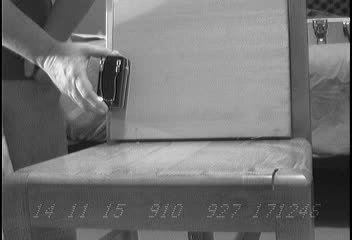Shutter tests for the Meade DSI Pro
Dave Gault
July 17, 2006
I spent all day yesterday preparing and doing, and this morning (Sunday)
analysing my experiment on the Meade Deep Sky Imager pro. The results are a
complete surprise to me and I hope can resolve some of the timing issues. So
without further chat... lets get started...
Goal
To understand the time line cycle of the Meade Deep Sky Imager pro (DSIpro)
Camera when used to collect images for time sensitive applications, i.e. the
Pluto Occultation.
Equipment
- DSIpro fitted with a Pentax 28mm lens controlled by DELL laptop PC.
- KIWI OSD system consisting of PC164c video camera (NTSC), 6" monitor, KIWI
OSD, GPS system to supply time standard, Canon Camcorder.
- Subject, a 12volt 1.3AH battery fitted with a Red LED,
mounted and swung on a string as a pendulum of 2.2metres length.
Method Summary
Setup the DSIpro camera and make 1 second exposures of a moving subject while
at the same time video the activity with a time inserter equipment (KIWI OSD)
and then correlate the two processes.
Method Details
- the laptop's clock was synced by use of the internet
feature of "date & time" control panel.
- the KIWI OSD system was setup and a GPS fix was obtained.
- the video camera was pointed at the laptop screen that
was showing the date & time control panel and it was found that
the laptop was 0.140 seconds slow to UTC
- the DSIpro was setup to record 1 second exposures,
saving all RAW frames, in FITS format, with combine images unchecked.
- Both the DSIpro and the video camera were pointed
at the subject and the Battery/LED assembly swung repeatedly to
gather many "one" second scans of the pendulum swing.
- look through the one second scans, watching for a
sequence that showed an obvious start and end.
Pay attention to the preceeding, and following scans
to ensure continuity. Make note of the time
as written in "properties" for that particular file.
- look through the videotape to find the corresponding section
and note the KIWI OSD display.
Analysis
- The scan that best meets the requirements has the
time listed in properties as 12:11:19am. This is converted
to 14:11:19UT. The next scan is 14:11:21UT.
Both these scans are assembled into one image, below:

- A .mpg movie file shows the battery/LED assembly in
my hand, it is released to swing to
the right, then to the left and my hand is removed from the
scene just after the maximum to the left swing
and the video ends just as the second right swing ends.
Below is a single frame from the MPEG movie;
click on the frame to see the entire movie.

- Analysis of the scans and the movie reveal...
- the 14:11:19UT scan starts at 14:11:17.653UT and the
LED leaves a lighter trail to the right,
pauses at the RH end of the swing and retraces the path
thereby making the trail more solid where the image
of the LED is double-up.
- the 14:11:19UT scan ends at 14:11:19.753UT.
Take note of the smudge on the wood below the LED trail.
The more solid section of the LED trail ends to the left of the smudge.
- the duration of the scan is 2 seconds even though
I have set the software for a 1 second exposure!
- the 14:11:21UT scan swings to the left, pauses
and swings to the right. My hand is shown very faintly
as it is removed from the scene just after the left swing.
Take note, the start of the swing seems to
be BEFORE the end of the previous image as if
is shown above the smudge.
There seems to be overlap in the two images.
Conclusions.
The time given in the properties for the particular file is
for the END of the exposure.
The exposure time is 2 seconds.
There is no dead time or image download time as it is all done on-the-fly.
There are some "shared photons" between images, maybe 2% or 3%.
Comments welcome

